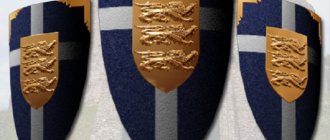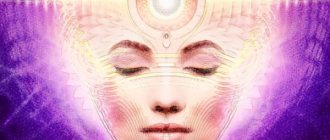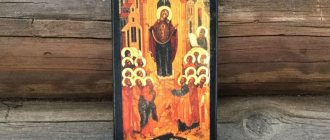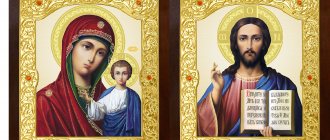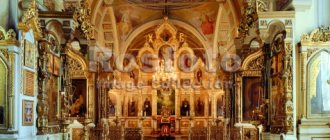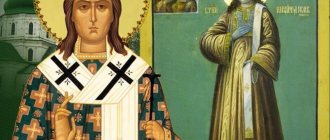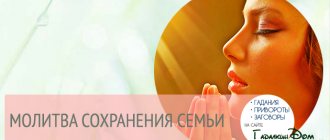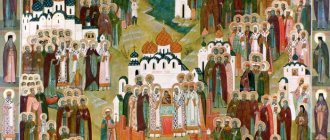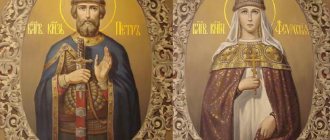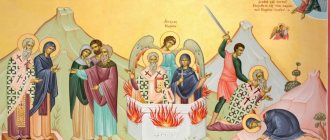Holy images help a person in prayer; the face of an Orthodox righteous man forces one to concentrate on the spoken words and does not allow one to be distracted. The image acts not only as a conductor between a person and the Lord, but also serves as a talisman for the home and peace of mind of the family. The icon, used to protect the family and home, is placed in a special designated place in the apartment. You can only pray to consecrated images. The amulet begins to have spiritual significance only after consecration; before that it is only a work of art
Use as amulets
The icon-amulet
Image is brought into the house to protect the family from exposure. Only those icons that are consecrated in the church carry power. Otherwise, it's just a piece of furniture. The believer treats images with love and reverence, reverence, and gives them a special place.
Properties of an icon as a talisman
- A person's attitude towards communication with God
- A reminder of the creation of the world, morality, ethics, the importance of leading a righteous life
- The power of healing, direction on the right path
Rules of Prayer
In order for the house to be protected by heavenly patrons, it is necessary to maintain strong faith and treat the faces with care. Prayer - an appeal to the saints must be sincere and focused. It is not necessary to memorize the text of the prayer rule; you can address the heavenly patrons in your own words.
In order to live in faith, peace, be confident in the future, and have a talisman for your home, life, and family in the form of heavenly patrons, it is important to follow the following rules of prayer:
- It is better to pray not only within the walls of your home, but also during the service within the walls of the temple;
- you can consecrate the house or sprinkle holy water in the corners;
- read daily prayer rules, thank the Lord for life, health, given blessings;
- It is recommended to bless the house with the sign of the cross when leaving it.
The face of the saint can be embroidered or mosaiced yourself; upon completion of the creative work, the image must be consecrated in the temple. While doing work, you need to think about the bright, say the words of prayer and ask the Lord for a blessing.
What are they and what do they protect?
They are divided according to the following criteria:
By technique:
- Embroidered: embroidered on fabric;
- Cast;
- Carved: solid wood;
- Printed or typographical: printed on paper;
- Altar: a folding icon made of several boards fastened in a special way, covered with an image;
- Mosaic: made using the mosaic technique;
- Picturesque: painted by an icon painter;
Picturesque icons are divided into:
- Encaustic: wax is added to the paint;
- Tempera: paints are based on natural pigment;
Example: the famous “Trinity” was written by Andrei Rublev in the 15th century for the Trinity Cathedral. The icon depicts three Angels who appeared to Abraham in the form of wanderers. Kept in the Tretyakov Gallery.
A good icon helps on the road
. Location:
- Brownies: stored at home (family, measured, wedding, personal, etc.);
- Temple: located in the temple;
- Wayfarers: help travelers on the road;
- External: participate in the procession;
- Vow: written on a given promise;
By value:
- Wedding: blesses the newlyweds in the Sacrament of Wedding. These are the faces of the Lord Pantocrator and the Most Holy Theotokos;
- Family: inherited;
- Personalized: image of the Patron Saint;
- Measured: an icon corresponding to the height of the child at birth, depicting the image of the Patron Saint;
- Holidays: the most important church holidays;
Example: “The Nativity of Christ.” It was written in the 15th century. Based on the birth of Jesus Christ in a cave in Bethlehem. The main icon of the holiday “Nativity of Christ”.
By plot:
- Images of the Holy Trinity;
- Icons of the Christological series: based on the Savior and the events of the Gospel. “Passionate” images (the crucifixion of Jesus Christ) are highlighted separately;
- Theotokos: image of the Mother of God and images of holidays associated with the Mother of God;
- Images of saints and ethereal powers;
- Images of events connected by sacred history, church holidays;
- Symbolic icons;
Feodorovskaya icon of the Mother of God
Example: “Theodorovskaya icon of the Mother of God.” The first mentions date back to the 12th century. Considered miraculous. Mikhail Fedorovich Roman was blessed with this Shrine when he was elected to the kingdom. Patroness of the House of Romanov. Kept in the women's Epiphany-Anastasia Monastery in the city of Kostroma.
By stylistic features:
The images are painted using the technique of a certain “school” of icon painting: Moscow, Novgorod, Kiev, Don, Tikhvin, etc.;
Example: “Tikhvin Icon of the Mother of God” was found in Tikhvin in 1383. Considered miraculous. According to legend, she saved the Tikhvin Mother of God Assumption Monastery from the Swedish invasion in 1613. Kept in the Tikhvin Dormition Monastery.
For family, children and parents
Since ancient times, images in the house were located in the “red corner”. Such shrines were of great value to the family. Passed on from generation to generation, they are called “family”.
Savior Not Made by Hands: is the patron saint of the family;
Saints Peter and Fevronia of Murom: patron saints of preserving marriage and family, preserving marital fidelity, giving the bride or groom;
Saints Joachim and Anna: pray for an unsettled personal life, for healing from infertility, for the health of children;
Holy Martyrs Adrian and Natalya: pray for a strong family, mutual understanding, help in everyday needs;
People pray to the icon of St. Nicholas the Wonderworker for health
Saint Nicholas the Wonderworker: pray for the health of children, marriage, the health of relatives;
Holy Martyrs Gury, Samon and Aviv: married women pray to them;
Holy Blessed Xenia of St. Petersburg: they pray for the protection of the home, helps young girls meet their spouse;
Holy Great Martyr Paraskeva: guardian of the family hearth and well-being;
Holy Blessed Matrona of Moscow: they pray for the gift of children, for peace in the family;
Icon of the Kazan Mother of God: they pray for healing, for family happiness and well-being;
“Unfading Color”: the granting of family harmony.
To protect your home and property from fire and other disasters
“Seven-shot” Mother of God: protects the house from fire, enemy attack, disease, poverty
“Burning Bush”: saves the house from fires, elements, disasters, misfortunes;
Saint Spyridon of Trimifuntsky: pray for improvement of financial situation, elimination of conflicts;
The image of John the Warrior: protecting the house from thieves and enemies;
Image of Nikita Novgorodsky: protects from the threat of fires;
“Indestructible Wall”: protects against fires and disasters;
From evil people, evil eye and damage
Ostrobramskaya Icon of the Mother of God
Ostrobramskaya Icon of the Mother of God: a talisman against quarrels and evil, damage;
Image of Saint Cyprian: praying for protection from evil tongues and the evil eye;
Icon of the holy martyr Tryphon: they pray for deliverance from witchcraft, the evil eye, and damage;
Mother of God of Svensko-Pechersk;
Icon of Vladimir-Orna;
Icon of Konevskaya;
"Deliverer";
“Theodore Tyrone”: protection from enemies and bad intentions;
From diseases
“Quick to Hear”: healing icon;
The image of the holy Healer Panteleimon: they pray for healing from diseases of the body and soul;
Bringing happiness and prosperity
Image of the Mother of God;
The image of Nikolai Ugodnik;
Out of envy
The icon of St. Nicholas the Wonderworker, the most beloved saint in the Orthodox faith, will help against envy and human malice, and therefore many believers turn to him for bright help. If you place the Orthodox face of the saint in the home iconostasis, it will protect the house from damage, malice and the evil eye, the envy of people, and will set household members up for positive thoughts and damage.
In practice, there are several options for icons, and the most popular of them is placed in a nursery or bedroom. The image of the militant, depicted on a horse, St. Nicholas the Wonderworker, with his arms apart, will protect from the darkest damage, remove the crown of celibacy, preserving happiness between spouses.
It will be better for small children if their parents hang an amulet with the face of this saint in his crib or around his neck. And if you are a business owner, be sure to place the Orthodox face of St. Nicholas the Wonderworker in your office or sales area, which will protect your competitors from envy and damage.
How to place icons at home
Traditionally, the images were located in the “red corner” (southeastern part of the house). The revolution of 1917 replaced the images of saints with portraits of leaders. During the Great Patriotic War, images of Saints began to gradually return to homes.
IMPORTANT! There are no clear rules for the placement of images of Saints in a room. It is not allowed to be placed in the bathroom, next to non-religious furnishings.
The place for icons should be free and accessible. This could be a wall, shelves, table. There may be candles, a prayer book, a lamp, and church books nearby.
How to pray to an icon correctly
Believers pray in the morning and before going to bed, before eating and after eating, before starting a task and at the end of it. Discipline and regularity are important.
In prayer, the attitude is important.
The spiritual attitude is important;- Prayer should be directed towards the image;
- You must approach the image, bow and cross yourself;
- You can read prayers by heart, you can use a prayer book;
- When reading a prayer, faith in divine power and help is important;
- It is possible to read prayers according to prayer books and akathists;
Human life before and after seeking help from amulets
A person’s unshakable belief in the icon-amulets installed at home significantly changes his worldview, material and moral principles. The table compares a person’s life activity before and after turning to amulets.
| Before | After |
| Frequent diseases with long treatment | Reduction of colds and other diseases |
| Quarrels with loved ones and neighbors | Normalization of relations |
| Malaise of family members from the evil eye | Lack of reaction to external negativity |
| Lack of milk in a breastfeeding mother | Adding breast milk |
| Headaches from being in a group of envious people | Softening their hearts |
By date of birth
December 22 - January 20: Venerable Seraphim of Sarov, Blessed Sylvester;
January 21 - February 20: image of Saints Cyril and Athanasius, “The Burning Bush”;
February 21 - March 20: Saint Alexis, Venerable Miletius of Antioch, Iveron Mother of God;
March 21 - April 20: St. George the Confessor, Innocent of Irkutsk, St. Sophronius, Kazan Icon of the Mother of God;
April 21 - May 20: “Helper of Sinners”, Apostle John the Theologian, Saint Tamara, Saint Stepan;
May 21 - June 21: St. Constantine, St. Alexei of Moscow, “Seeking the Lost,” Icon of the Mother of God “Vladimir”;
June 22 - July 22: St. Cyril, “Joy of All Who Sorrow,” Our Lady of Kazan;
July 23 - August 23: Prophet Elijah, Saint Nicholas the Pleasant, “Protection of the Most Holy Mother of God”;
August 24 - September 23: Saint Righteous John the Russian, Paul, Saint Alexandra, "Passionate";
September 24 - October 23: St. Sergei of Radonezh, icon of the Pochaev Mother of God;
October 24 – November 22: St. Paul, “Quick to Hear,” “Jerusalem” Mother of God;
November 23 - December 21: Saint Barbara of Iliopol, Nikolai Ugodnik, “The Sign”, “Tikhvin”;
Iveron Mother of God
Select by name
A personalized icon is a mediator between man and God. The name given at the Sacrament of Baptism influences the formation of personality. Name days have always been honored and celebrated. Believers treat with special trepidation when choosing a name, and subsequently, when choosing an icon. When performing the Sacrament of Baptism, a person receives the name of his Patron Saint.
IMPORTANT! A person is given a new name by the name of the Saint in whose honor he is baptized.
Before choosing a personalized icon, you need to find out the name given at the Sacrament of Baptism. It is recorded in the certificate of Baptism. It is possible to choose a patron saint without reference to a name. You can also be baptized by the Saint to whom your soul “lies.” The Patron becomes the Saint whose Memorial Day is close in date to the date of Birth. Saints' Memorial Days are found on the church calendar. If the name is not in the church calendar, at Baptism a name will be given that is consonant with the first name (Alina - Aleftina, Matvey - Matthew, etc.) After Baptism, an icon with the name of the Saint is selected. They pray to the patron for health, help with needs, and solutions to problems.
It is not the icon purchased for the home that is important. The meaning put into the acquired image is important. An image acquired with good intentions will certainly bring protection and benefit.
